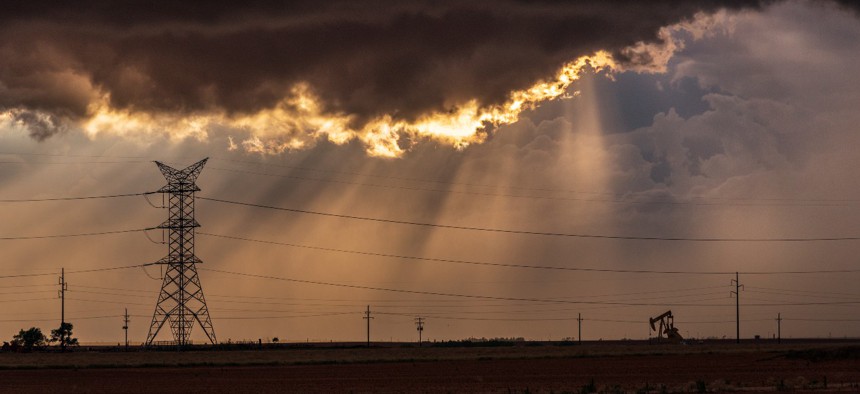
Keeping the environment in mind during federal purchasing decisions can help reduce climate change, which contributes to natural disasters. john finney photography / Getty Images
The Federal Government Can Use Its Buying Power to Help the Environment and Save Taxpayers Money
Even small shifts in procurement rules that encourage reductions in greenhouse gas emissions will have a ripple effect.
Federal disaster spending for hurricanes, flooding, drought and wildfires now exceeds the budgets of some federal agencies, and this cost is growing: Americans pay more than $120 billion per year in climate-related disaster aid, and this is just the tip of the proverbial iceberg—an iceberg that is melting faster every year. The costs of climate change are like a tax that we must all now pay.
Natural disasters and extreme weather events are becoming more devastating and costly because of human-induced climate change attributable largely to the massive burning of fossil fuels over the past century.
Happily, we still have tools that can be used to mitigate the risks and costs of dealing with this unfolding crisis.
A critical tool to help reduce the risks and impacts of climate change is to reform the federal government’s purchasing decisions. Federal government spending makes up about 29% of U.S. Gross Domestic Product and shapes markets for goods and services across the economy.
Pointing government procurement and the broader economy in a more climate-friendly direction is good for taxpayers.
The average number of major and catastrophic disaster declarations, which trigger federal spending, has more than doubled from 22 annually between 1953 and 1989 to 52 per year since 1990. The National Oceanic and Atmospheric Administration reports that since 1980, there have been 341 weather and climate disasters where overall damages/costs reached or exceeded $1 billion, adding up to a staggering $2.5 trillion (that’s trillion, with a “t”), with more than 85% of these declarations occurring in the wake of climate-related occurrences—severe storms, hurricanes, floods, droughts, or other weather events.
In 2022 alone, weather and climate related disasters cost $165 billion, knocking 2021–at $145 billion–to fourth on the list.
Add to these billions the costs of mitigating the risks of future climate events. From 2,500 to 4,600 bridges across the United States will be vulnerable to increased inland flooding by 2050, resulting in average costs of $1.2 billion to $1.4 billion each year.
These increasing costs of mitigating climate change damages contain the kernel of a solution that the federal government can leverage by focusing—or refocusing—some of its own procurement policies. Though less headline-grabbing than billions in new spending, federal government procurement practices over the years have helped spur the rapid growth of technologies that have enabled American companies to dominate international markets in industries ranging from information technology to clean energy, and telecommunications to health care.
Now, as the climate crisis becomes more urgent and costly for taxpayers, the federal government must include climate-protection incentives in its acquisition standards.
Thankfully, the Federal Acquisition Regulatory Council is proposing to require that government suppliers measure and report their greenhouse gas emissions and develop goals to reduce them. Importantly, it also proposes to use this new information as a factor in procurement decisions.
The Federal Acquisition Regulation, or the “FAR,” directs purchasing for the General Services Administration, NASA and the Pentagon. Thanks to the Pentagon’s huge impact on the federal contracting community, even small shifts in procurement rules designed to measure and reduce greenhouse gas emissions will ripple through the economy. As an example of this beneficial ripple effect, the Pentagon’s procurement request alone for fiscal 2023 was $146 billion. Even without the other federal agencies covered by the FAR, having greenhouse gas data as a factor in deciding procurements that add up to such a sum has the power to change the habits of major U.S. corporations.
Secretary of Defense Lloyd Austin and his predecessors have decried climate change as a threat to our national security and even as a “threat multiplier,” citing both the operational damage and disruption of intensifying natural disasters as well as the widespread instability and conflict these events create. More than 1 billion people will be displaced by climate change in the next 30 years, leading to massive, forced migrations. Climate change not only disrupts operations, but threatens supply chains, making the contractor climate risk information sought by this FAR rule change critical.
Last year, in the Inflation Reduction Act, Congress committed $369 billion to programs designed to reduce greenhouse gas emissions and slow climate change. Incorporating these goals into federal acquisition policies is a cost-effective way to achieve the same beneficial results.
Government has long used strategic procurement to foster goals, like set-asides for small businesses or women-, minority- and veteran-owned businesses. Now, it makes sense to use this important tool to reduce climate risk and its cost on taxpayers. Along the way, this procurement reform would help safeguard human lives, protect property and, not least of all, keep the nation secure.
Steve Ellis is president of Taxpayers for Common Sense (Twitter: @taxpayers) a nonpartisan budget watchdog that has served as an independent voice for the American taxpayer since 1995. It works to ensure that taxpayer dollars are spent responsibly and that government operates within its means.






